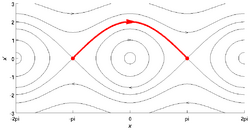Heteroclinic orbit

In mathematics, in the phase portrait of a dynamical system, a heteroclinic orbit (sometimes called a heteroclinic connection) is a path in phase space which joins two different equilibrium points. If the equilibrium points at the start and end of the orbit are the same, the orbit is a homoclinic orbit.
Consider the continuous dynamical system described by the ordinary differential equation [math]\displaystyle{ \dot x = f(x). }[/math] Suppose there are equilibria at [math]\displaystyle{ x=x_0,x_1. }[/math] Then a solution [math]\displaystyle{ \phi(t) }[/math] is a heteroclinic orbit from [math]\displaystyle{ x_0 }[/math] to [math]\displaystyle{ x_1 }[/math] if both limits are satisfied: [math]\displaystyle{ \begin{array}{rcl} \phi(t) \rightarrow x_0 &\text{as}& t \rightarrow -\infty, \\[4pt] \phi(t) \rightarrow x_1 &\text{as}& t \rightarrow +\infty. \end{array} }[/math]
This implies that the orbit is contained in the stable manifold of [math]\displaystyle{ x_1 }[/math] and the unstable manifold of [math]\displaystyle{ x_0 }[/math].
Symbolic dynamics
By using the Markov partition, the long-time behaviour of hyperbolic system can be studied using the techniques of symbolic dynamics. In this case, a heteroclinic orbit has a particularly simple and clear representation. Suppose that [math]\displaystyle{ S=\{1,2,\ldots,M\} }[/math] is a finite set of M symbols. The dynamics of a point x is then represented by a bi-infinite string of symbols
- [math]\displaystyle{ \sigma =\{(\ldots,s_{-1},s_0,s_1,\ldots) : s_k \in S \; \forall k \in \mathbb{Z} \} }[/math]
A periodic point of the system is simply a recurring sequence of letters. A heteroclinic orbit is then the joining of two distinct periodic orbits. It may be written as
- [math]\displaystyle{ p^\omega s_1 s_2 \cdots s_n q^\omega }[/math]
where [math]\displaystyle{ p= t_1 t_2 \cdots t_k }[/math] is a sequence of symbols of length k, (of course, [math]\displaystyle{ t_i\in S }[/math]), and [math]\displaystyle{ q = r_1 r_2 \cdots r_m }[/math] is another sequence of symbols, of length m (likewise, [math]\displaystyle{ r_i\in S }[/math]). The notation [math]\displaystyle{ p^\omega }[/math] simply denotes the repetition of p an infinite number of times. Thus, a heteroclinic orbit can be understood as the transition from one periodic orbit to another. By contrast, a homoclinic orbit can be written as
- [math]\displaystyle{ p^\omega s_1 s_2 \cdots s_n p^\omega }[/math]
with the intermediate sequence [math]\displaystyle{ s_1 s_2 \cdots s_n }[/math] being non-empty, and, of course, not being p, as otherwise, the orbit would simply be [math]\displaystyle{ p^\omega }[/math].
See also
- Heteroclinic connection
- Heteroclinic cycle
- Heteroclinic bifurcation
- Homoclinic orbit
- Traveling wave
References
- John Guckenheimer and Philip Holmes, Nonlinear Oscillations, Dynamical Systems, and Bifurcations of Vector Fields, (Applied Mathematical Sciences Vol. 42), Springer
 |

